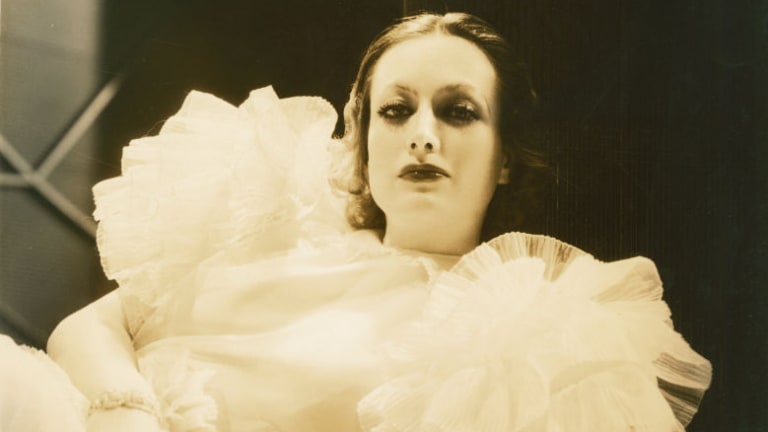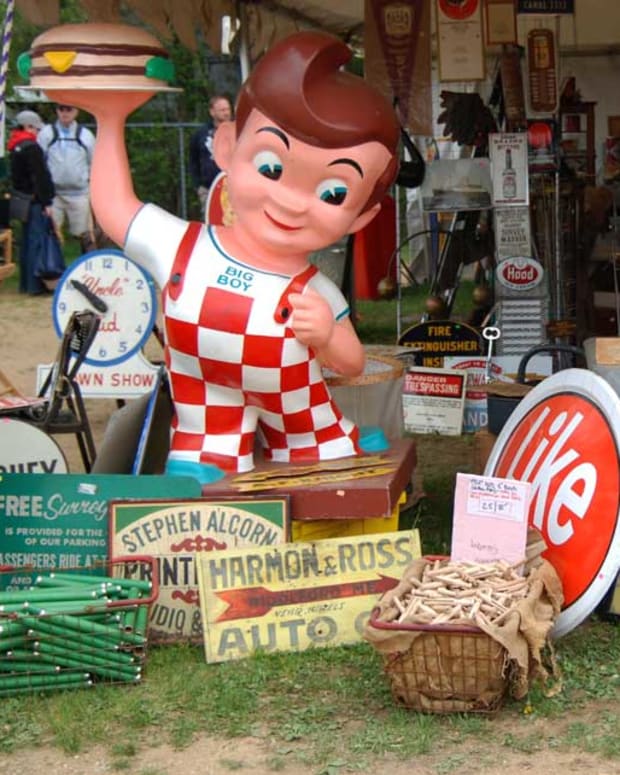
The ‘Letty Lynton’ Dress Took Country By Storm
Renowned Hollywood costume designer Adrian Greenberg once said, "Who would have thought that my entire reputation as a designer would rest on Joan Crawford's shoulders?"
And it did rest on the star’s shoulders - literally.
The designer, known later as just Adrian, was one of America's most distinguished stylemakers from cinema's golden years. He created famous costumes for The Wizard of Oz, including those famous ruby slippers, and hundreds of Metro-Goldwyn-Mayer films between 1928 and 1941. His ideas and designs were so fresh and original that he earned the film credit, "Gowns by Adrian." He was the first, if not the most publicized, of a Hollywood hybrid known as the costume designer/couturier. Besides Crawford, he dressed some of Hollywood's other elite, including Katharine Hepburn, Norma Shearer and Greta Garbo.
Adrian and Crawford had collaborated on several movies prior, but it was the 1932 pre-Code melodrama, Letty Lynton, that cemented their roles in Hollywood and it was all due to a white cotton organdy gown that, according to Adrian, was "amusing but a trifle extreme." With its dramatically poofy sleeves and relaxed silhouette that were a big departure from the slinky, streamlined silhouette popular at the time, the dress caused a sensation. It also put Paris on notice that Hollywood designers were a new force in fashion. The dress became synonymous with 1930s Hollywood fashion and defined Adrian's reputation as the quintessential Hollywood designer. It also ushered in the eventual padded-shoulder craze that would take hold later in the decade and into the '40s. Strong-shouldered trim suits even became Crawford's signature look.
The impact the dress made was remarkable not only from a design standpoint, but the fact that the movie was not widely seen, as it was removed from circulation due to a plagiarism lawsuit. The film remains commercially unavailable today.

Joan Crawford wearing the famous Letty Lynton dress, 1932, designed by Adrian. It was knocked off by designers everywhere including Parisian couturiers.
Photo by George Hurrell and courtesy of MGM
Dresses with big shoulders were not a new phenomenon before 1932. A century earlier, gigot sleeves were making bold fashion statements. Also called the leg-of-mutton sleeve for its resemblance to a sheep’s hind leg, these sleeves were full at the shoulder, decreasing in size toward the elbow and gradually becoming tight at the wrist.

Cotton dress, 1832–35, American, designer unknown. The large gigot sleeves were popular from the early 1830s through 1836 when they began to diminish to the tightly fitted sleeves of the following period.
Courtesy of the Met Museum

Day dress, c. 1895, Gustave Beer, Paris. Bouclé silk two-piece dress with gigot sleeves, collar and yoke of layered silk satin and twill with cut work and bead embroidery; crescent-shaped velvet decoration on collar and shoulders; beige silk satin visible through all-over slit.
Courtesy of the Kyoto Costume Institute
They were one of the most distinctive elements of 1830s fashion, and returned to prominence during the 1890s, growing to their fullest proportions around the middle of the decade.
At the time Adrian was designing the costumes for Letty Lynton, the standard 1930s' silhouettes were all slinky satin and lamé that clung to a woman's curves:

Dress by Jean-Charles Worth, 1931, demonstrating his talent for embracing a modern aesthetic and silhouette. Composed of silk tulle, the gown is densely embroidered with silver glass bugle beads that extend into deep layers of fringe and are worked into intricate braids at the shoulders.
Courtesy of the Met Museum

Light green satin dress, c. 1932, worn by Eleanor Middleton Rutledge Hanson for her second court visit at Buckingham Palace in 1932.
Courtesy of Charleston Museum
He was reportedly told by the movie studio to "hide" Crawford's broad shoulders and the puffy sleeves were meant to accommodate them, but he also created this other sleek and striking gown for Crawford in Letty Lynton that was in line with the current style - and that showcased her shoulders beautifully:

In this publicity photo, shot on the set of another Crawford movie, “Grand Hotel,” the star wears another gown from "Letty Lynton" in the sleeker silhouette popular at the time. The gown is made of white crepe and black bugle beads.
Photo by George Hurrell and courtesy of MGM
In the movie, Crawford plays a socialite of the title name, who begins a shipboard romance with a wealthy man. When she is blackmailed by a former lover and can't escape his abuse, she poisons him and gets away with it by pretending to be innocent. The famous Letty Lynton dress was designed to make her appear both innocent and flirtatious, and the frothy, ruffled confection, with its turbo-charged sleeves, captured the imagination of American women and made thousands of them covet it. The dress tapped into a collective postwar need for romance, and helped kick off the trend for romanticism and heightened femininity, with a lot of adornment and excessive fabrics.
Hollywood was just then beginning to influence American fashion as Paris long had, and in 1930, eight million Americans went to the movies every week. Film studios began working with retailers to tie in movie fashions with ready-to-wear clothing. During Hollywood’s Golden Age, American woman looked to movies for their fashion cues, and women across the world did, too.

The dress has several different neo-Victorian elements, a trend that was gaining popularity as women sought a more feminine look after the flapper style of the 1920s.
John Kobal Foundation/Getty Images
After the movie debut, a 1932 issue of Silver Screen magazine declared: “Paris may decree this and Paris may decree that, but when that Crawford girl pops up in puffed sleeves, then it’s puffed sleeves for us before tea time.”
When the Letty dress struck such a chord, Seventh Avenue took notice and copied it, and Macy's alone sold more than 50,000 of a $10 version, according to The New York Times. There are also reports that 500,000 copies were sold. This lesson was not lost, and a year later, Macy's established a "cinema shop" to sell hot film fashions.
Soon puffed sleeves were everywhere. Sears offered a cheaper version in its 1933 catalog, and countless other knock-offs and similar dress patterns were sold between 1932-1935. The dress has been credited with revolutionizing American fashion via Hollywood’s massive influence on the public’s buying habits. This puffy-sleeve silhouette soon moved away from purely evening wear and was seen in more modified modes in day wear in sun dresses, blouses, sweaters, and wedding dresses. The new look didn't entirely replace that slinky shoulder-less silhouette, as women didn't have to choose one or the other. Boleros and evening jackets with flouncy sleeves soon came into vogue that would allow women to play around with both of these dress forms and wear their sleek dresses and still get that Letty Lynton look.

A department store version of the Letty Lynton evening dress, 1933, maker unknown. Since the original dress was too expensive to recreate, most copies just added interesting sleeves.
Courtesy of Chicago History Museum

Blue and white floral-print house dress, c. 1933, maker unknown. During the Great Depression, many women refashioned old clothes into something new. This dress is a repurposed summer dress, and although the maker wore it to do housework and run errands, the large sleeves echo the Letty Lynton style. Even housewives at home wanted to look and feel like glamorous heroines.
Courtesy of Chicago History Museum
According to the book, Cinematic Flashes: Cinephilia and Classical Hollywood, by Rashna Wadia Richards, Adrian’s revival of the outmoded 1800s' sleeves and addition of other assorted elements including a Buster Brown collar, the hip treatment and the flared bottom of the skirt, both ruffled and tucked, was put together almost inadvertently as a collage, out of bits and pieces of certain eras. He confessed to Ladies Home Journal that the Letty Lynton dress “may have seemed to have several ideas.” The book also notes that the dress was reportedly produced by as many as 250 tailors, cutters, beaders, embroiderers, jewel craftsmen, feather workers and seamstresses.
Adrian seemed surprised by the popularity and is quoted in Creating the Illusion as saying: “The first time I became conscious of the terrific power of the movies was some months after Letty Lynton was released. I came to New York and found that everyone was talking about the Letty Lynton dress. I had to go into the shops to discover that of all the clothes I had done for Crawford in that film, it was a white organdy dress with big puffed sleeves that made the success. In the studio, we thought the dress was amusing but a trifle extreme. The copies of it made the original Letty Lynton look very modest and shy.”
Legendary and award-winning costume designer Edith Head thought the dress was the "single most important influence on fashion in film history."
High praise, indeed, and its influence has been seen through the decades in gowns made by famous fashion designers including Valentino and Karl Lagerfeld for Chanel.

This 1973 white chiffon evening dress with cyclamens by Valentino channels Letty Lynton's '30s nostalgia of romance and femininity that was sweeping the world of fashion during that decade.
Courtesy of Valentino

Chanel channeled the Letty Lynton dress in its spring 2017 couture collection.
Courtesy of Yannis Vlamos / Indigital.tv

At the 2020 Oscars, actress Sandra Oh channeled classic Hollywood in this Elie Saab creation that pays homage to the iconic Letty Lynton dress.

Although the sleeves of Joan Collins' dress have a Letty Lynton vibe, I don't know if costume designer Nolan Miller was influenced by the dress when he created the fashions for the 1980s’ TV series, “Dynasty.” What I do know is that there’s an unwritten fashion rule dictating that you can never mention power shoulders without giving a shout-out to that show, so here you go.
Courtesy of ABC
Crawford, who collaborated with Adrian through 1945's Mildred Pierce, said of the designer: "Dear Adrian. He was the greatest costume designer of them all. There will never be a greater one."
You can see why the romance of the dress would have captivated audiences in this 4-minute Youtube clip:
You might also like:
Edith Head's Costume Designs for White Christmas
Inside the Closet of Fashion Icon Marjorie Merriweather Post












